Abstract
The influence of beta blockade on the ability of ST depression, during pre-discharge exercise testing, to predict coronary anatomy and subsequent complications was studied in 300 consecutive post-infarct patients, 125 of whom underwent cardiac catheterisation. At the time of exercise 62 patients were taking a beta blocker. The exercise test had a higher sensitivity in predicting multivessel disease in patients who were not taking beta blockers than in patients who were (95% v 76%). beta Blockade did not, however, influence the ability of the test to identify patients at risk of subsequent cardiac events (sensitivity 84% and 85% respectively). These results suggest that it is not necessary to stop treatment with beta blockers before predischarge exercise testing of patients who have had an acute myocardial infarction.
Full text
PDF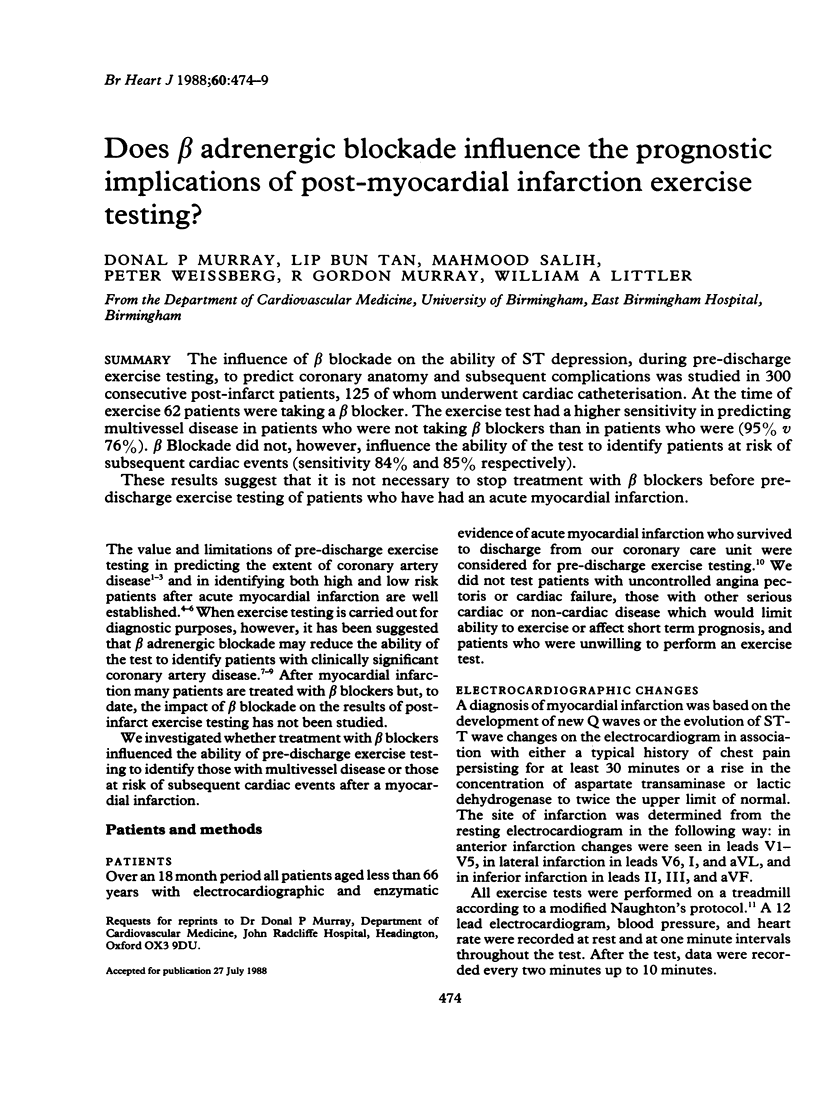
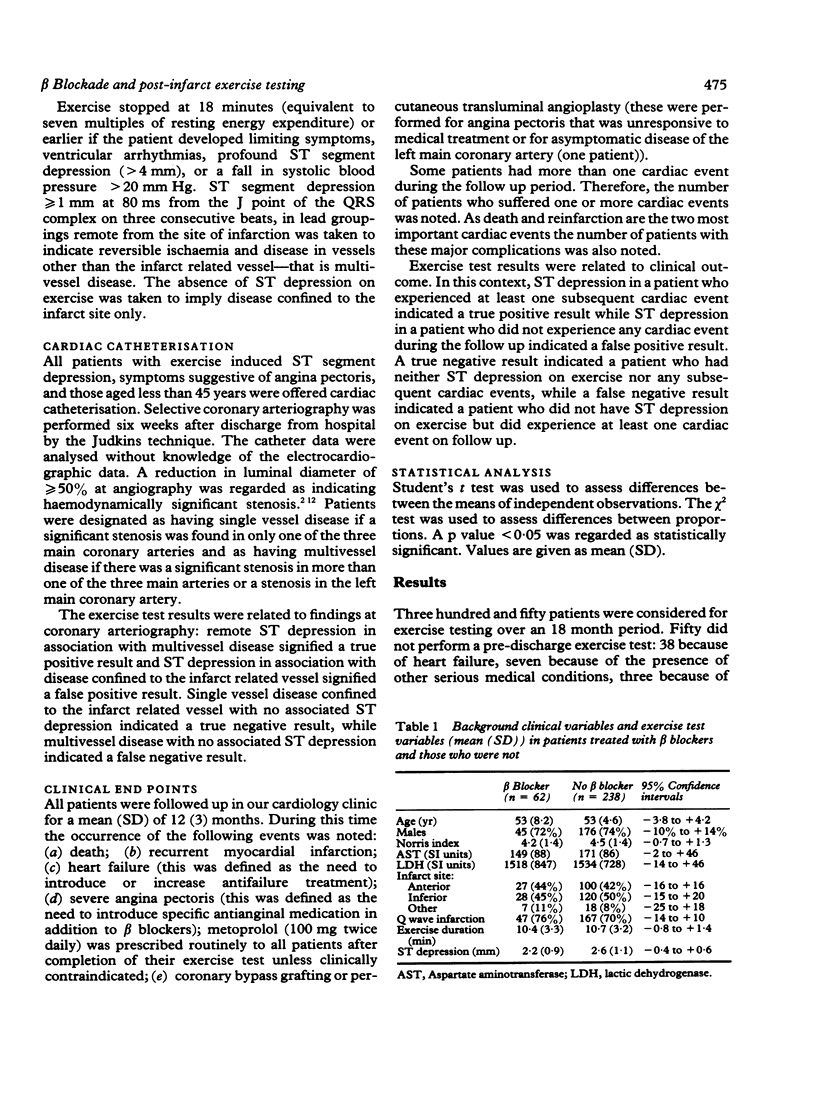
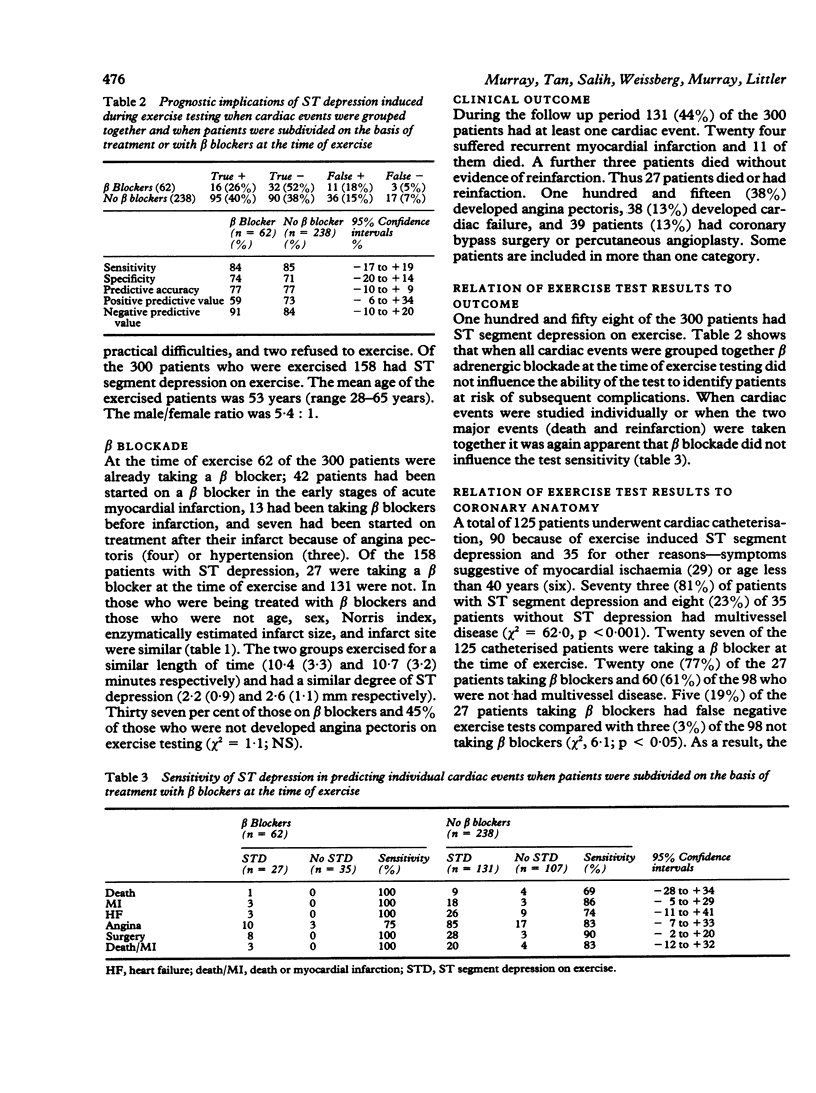
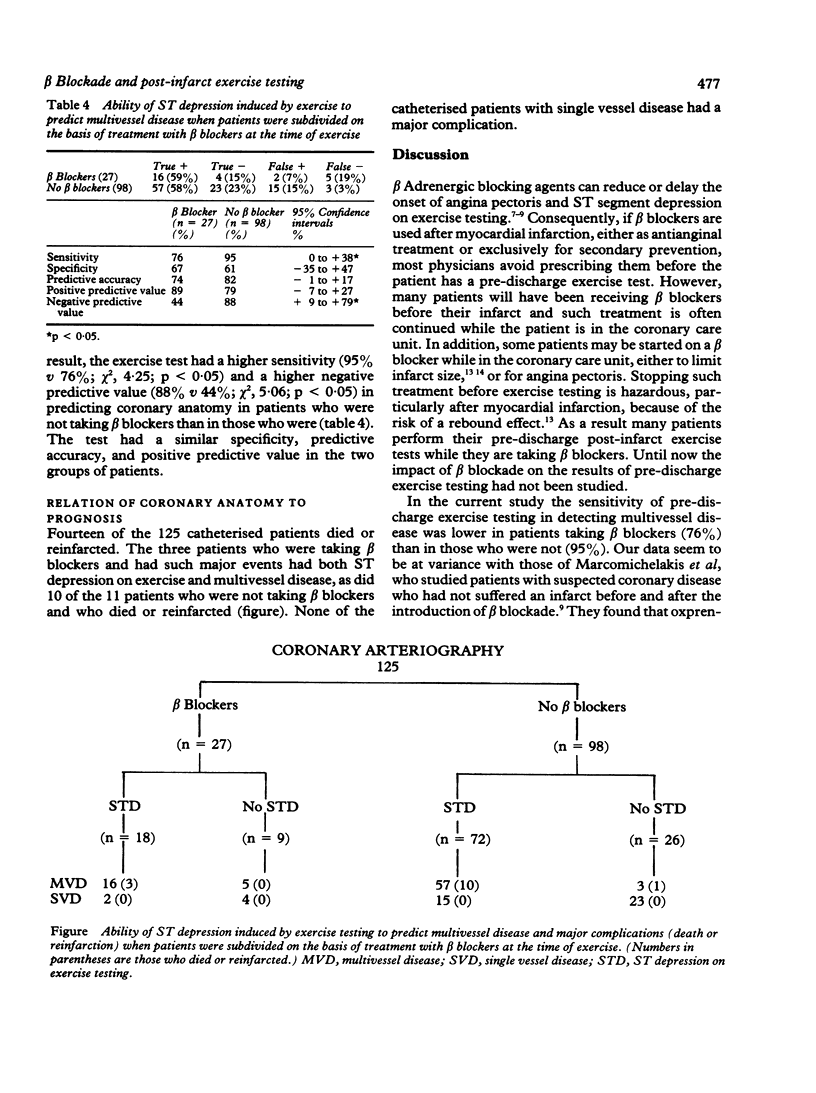
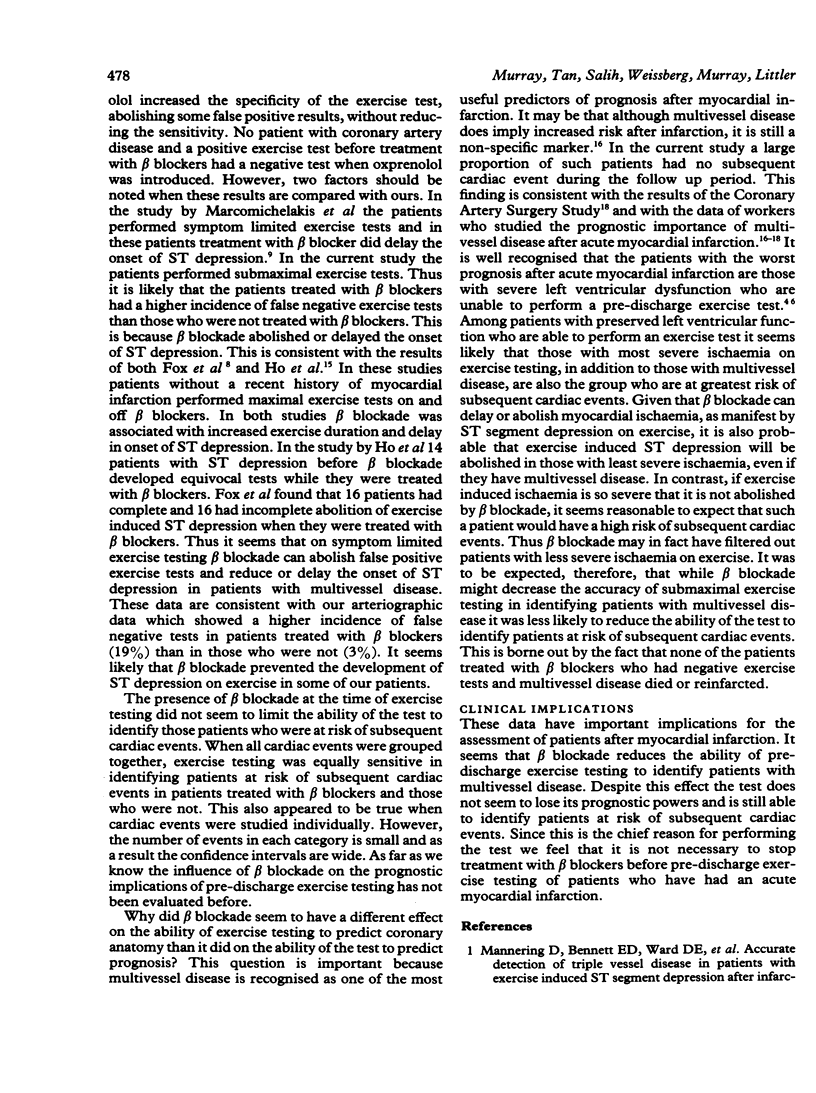
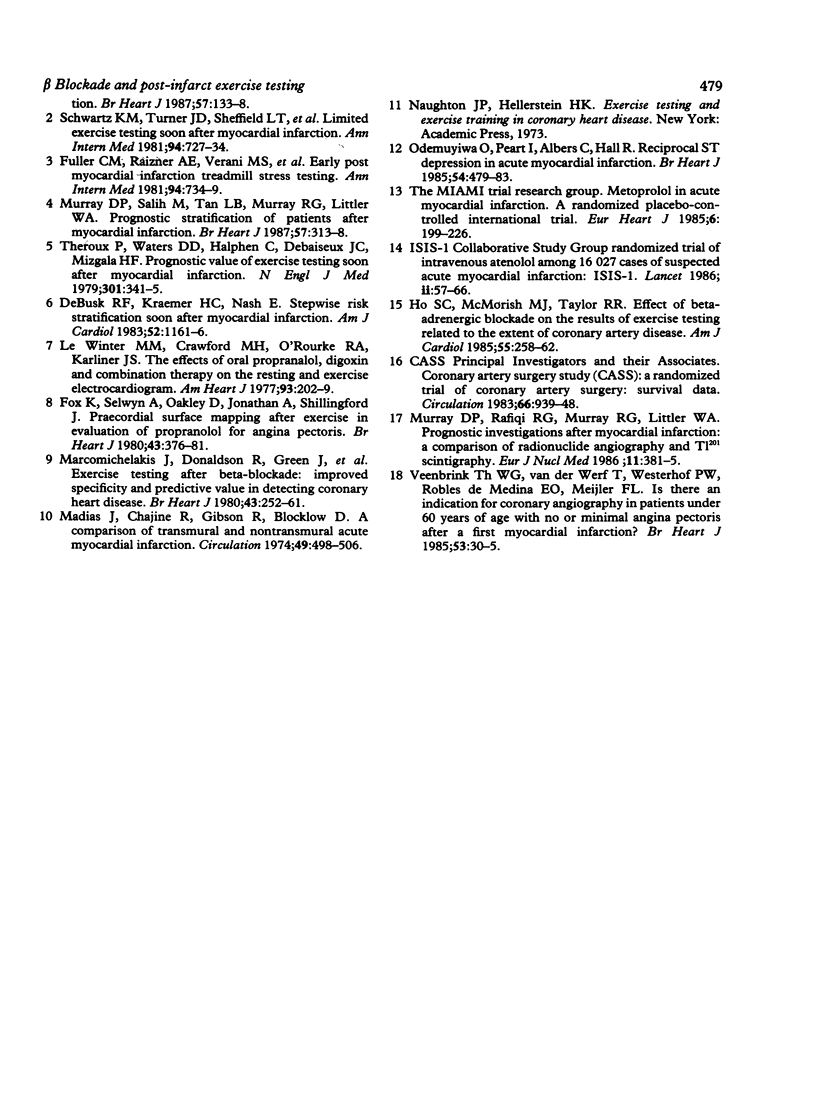
Selected References
These references are in PubMed. This may not be the complete list of references from this article.
- DeBusk R. F., Kraemer H. C., Nash E., Berger W. E., 3rd, Lew H. Stepwise risk stratification soon after acute myocardial infarction. Am J Cardiol. 1983 Dec 1;52(10):1161–1166. doi: 10.1016/0002-9149(83)90567-2. [DOI] [PubMed] [Google Scholar]
- Fox K., Selwyn A., Oakley D., Jonathan A., Shillingford J. Praecordial surface mapping after exercise in evaluation of propranolol for angina pectoris. Br Heart J. 1980 Apr;43(4):376–381. doi: 10.1136/hrt.43.4.376. [DOI] [PMC free article] [PubMed] [Google Scholar]
- Fuller C. M., Raizner A. E., Verani M. S., Nahormek P. A., Chahine R. A., McEntee C. W., Miller R. R. Early post-myocardial infarction treadmill stress testing. An accurate predictor of multivessel coronary disease and subsequent cardiac events. Ann Intern Med. 1981 Jun;94(6):734–739. doi: 10.7326/0003-4819-94-6-734. [DOI] [PubMed] [Google Scholar]
- Ho S. W., McComish M. J., Taylor R. R. Effect of beta-adrenergic blockade on the results of exercise testing related to the extent of coronary artery disease. Am J Cardiol. 1985 Feb 1;55(4):258–262. doi: 10.1016/0002-9149(85)90356-x. [DOI] [PubMed] [Google Scholar]
- LeWinter M. M., Crawford M. H., O'Rourke R. A., Karliner J. S. The effects of oral propranolol, digoxin and combination therapy on the resting and exercise electrocardiogram. Am Heart J. 1977 Feb;93(2):202–209. doi: 10.1016/s0002-8703(77)80312-8. [DOI] [PubMed] [Google Scholar]
- Madias J. E., Chahine R. A., Gorlin R., Blacklow D. J. A comparison of transmural and nontransmural acute myocardial infarction. Circulation. 1974 Mar;49(3):498–507. doi: 10.1161/01.cir.49.3.498. [DOI] [PubMed] [Google Scholar]
- Mannering D., Bennett E. D., Ward D. E., Dawkins K., Dancy M., Valantine H., Mehta N. Accurate detection of triple vessel disease in patients with exercise induced ST segment depression after infarction. Br Heart J. 1987 Feb;57(2):133–138. doi: 10.1136/hrt.57.2.133. [DOI] [PMC free article] [PubMed] [Google Scholar]
- Marcomichelakis J., Donaldson R., Green J., Joseph S., Kelly H. B., Taggart P., Somerville W. Exercise testing after beta-blockade: improved specificity and predictive value in detecting coronary heart disease. Br Heart J. 1980 Mar;43(3):252–261. doi: 10.1136/hrt.43.3.252. [DOI] [PMC free article] [PubMed] [Google Scholar]
- Murray D. P., Rafiqi E., Murray R. G., Littler W. A. Prognostic investigations after myocardial infarction: a comparison of radionuclide angiography and 201Tl scintigraphy. Eur J Nucl Med. 1986;11(10):381–385. doi: 10.1007/BF00261401. [DOI] [PubMed] [Google Scholar]
- Murray D. P., Salih M., Tan L. B., Murray R. G., Littler W. A. Prognostic stratification of patients after myocardial infarction. Br Heart J. 1987 Apr;57(4):313–318. doi: 10.1136/hrt.57.4.313. [DOI] [PMC free article] [PubMed] [Google Scholar]
- Odemuyiwa O., Peart I., Albers C., Hall R. Reciprocal ST depression in acute myocardial infarction. Br Heart J. 1985 Nov;54(5):479–483. doi: 10.1136/hrt.54.5.479. [DOI] [PMC free article] [PubMed] [Google Scholar]
- Schwartz K. M., Turner J. D., Sheffield L. T., Roitman D. I., Kansal S., Papapietro S. E., Mantle J. A., Rackley C. E., Russell R. O., Jr, Rogers W. J. Limited exercise testing soon after myocardial infarction. Correlation with early coronary and left ventricular angiography. Ann Intern Med. 1981 Jun;94(6):727–734. doi: 10.7326/0003-4819-94-6-727. [DOI] [PubMed] [Google Scholar]
- Théroux P., Waters D. D., Halphen C., Debaisieux J. C., Mizgala H. F. Prognostic value of exercise testing soon after myocardial infarction. N Engl J Med. 1979 Aug 16;301(7):341–345. doi: 10.1056/NEJM197908163010701. [DOI] [PubMed] [Google Scholar]
- Veenbrink T. W., van der Werf T., Westerhof P. W., Robles de Medina E. O., Meijler F. L. Is there an indication for coronary angiography in patients under 60 years of age with no or minimal angina pectoris after a first myocardial infarction? Br Heart J. 1985 Jan;53(1):30–35. doi: 10.1136/hrt.53.1.30. [DOI] [PMC free article] [PubMed] [Google Scholar]


